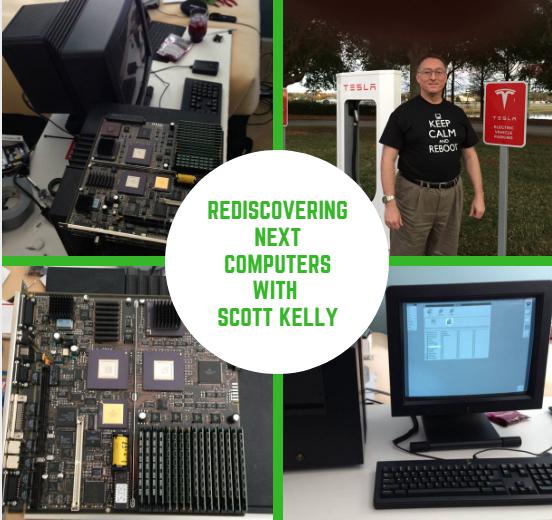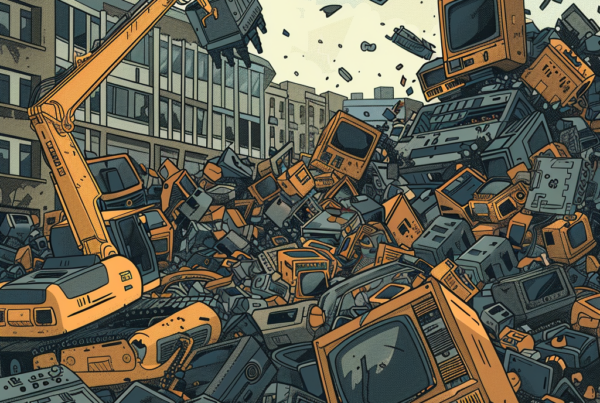By. Michael Condra
32 years ago Steve Jobs was ousted from Apple, leading him to start NeXT Inc. and continuing the crystallization of his personal computer vision. During this time, Scott Kelly, an engineer and technology enthusiast from Atlanta, witnessed the birth of the modern computer era with NeXT computers. I recently spoke with Scott after he donated one of the original NeXT computers to human-I-T. Personal computers were in use for nearly 10 years by 1985, but the inventive NeXT operating system facilitated the modern Mac OS X still utilized in Apple computers today.
Scott Kelly is a Senior Director at Avanade, the world’s leading integrator of Microsoft technologies. He has lead deployments of “90,000 Microsoft Windows 10” software licenses at a time for clients and businesses on a global scale and has led the deployment of more than 350,000 end-user devices overall. Prior to working at Avanade, Scott studied Electrical Engineering at Georgia Tech, after which he worked for the U.S. Navy “in the Atlantic and Mediterranean in a Lockheed P3 Orion” and clocking in over “1700 hours” of flight time. After his squadron time, he proceeded to the Naval Postgraduate School for his Masters in Electrical Engineering.
Just before Scott attended the Naval Postgraduate School, Steve Jobs released the Lisa, one of the most advanced personal computers at the time. It was the “first commercial computer with a graphical user interface (GUI),” which separated the Lisa from Apple’s previous models. Even though Lisa marked a turning point in personal computers, the high price tag and low sales made it difficult for Apple to continue production. By 1985, John Sculley (former CEO of Apple) and the board of directors discontinued the Lisa and Jobs was forced out of the company he had founded.
“Growing up in the late 1970’s and early 80’s, Scott says he has “always been fascinated with computers,” especially in 1975 when, “Ed Roberts launched the Altair 8800 into the world.” “That’s when I first really discovered the magic [of computers] and was just captivated, absolutely captivated with this thing,” he says. Scott states that “the 1980’s were the best years of being a geek,” because that’s “when the then now future was really invented.”
Growing up in the late 1970’s and early 80’s, Scott says he has “always been fascinated with computers,” especially in 1975 when, “Ed Roberts launched the Altair 8800 into the world.” “That’s when I first really discovered the magic [of computers] and was just captivated, absolutely captivated with this thing,” he says. Scott states that “the 1980’s were the best years of being a geek,” because that’s “when the then now future was really invented.” The 1980’s witnessed the development of the ethernet, the Macintosh, early version of Windows OS, IBM machines, Compaq Computers and others that dived into the nascent industry of personal computers.
The next step for Jobs was bringing together a team of former Apple engineers to start NeXT Computers. A few of these engineers previously worked on the Macintosh and the Lisa computer who agreed to help Jobs develop the NeXT Cube and NeXTstation. According to lowendmac.com, these machines were developed in January of 1986. “One of the earliest decisions was to have NeXTstep (the name Jobs had chosen for NeXT’s operating system) run on a microkernel. This meant that the operating system would be split into several different “servers” that ran independently of each other. This had two of advantages: 1) if one server crashed, it could be restarted without restarting the entire operating system. 2) It meant that very little software dealt directly with the hardware, making the operating system very easy to move to different platforms.”
The operating system attracted the attention of large companies and government agencies that wanted a computer packed with versatile programs. With the NeXTStep operating system it used “the PostScript language for all input and output. All includes displaying information on the monitor, reading and writing files from a disk, the expected task of printing files on a printer, and even includes transmitting them by a modem.” “What he built at NeXT is the foundation for OS X,” Scott says
Just a few years before Apple purchased NeXT Computers for $400 million, Scott was at the Naval Sea Systems Command where he got “a chance to play with a NeXT slab.” Rear Admiral Jack Donovan, Scott’s commanding officer who ran the advanced combat systems directorate, invited him to try out the machine. Curious with the NeXT computer, Scott says he “liked it a whole lot.” Scott was impressed with the design saying that he “could see the potential in it and the promise in” the NeXT computer. Despite weak sales, the computer’s software made a lasting impact on Apple’s eventual renaissance in the late 90’s. “You see the DNA of OS X in there, you see how far ahead this thing actually was,” Scott says,
“What he built at NeXT is the foundation for OS X.” – Scott Kelly
Flash forward to 2011: Scott was determined to find one of the original models built by Jobs in 1988. “I was always fascinated with it and bound to have one,” and after looking around for years he finally discovered one for sale on eBay. When he received the machine, Scott says that it was “pretty beat up” and in a “non-working state” with some of the components needing to be replaced. Both the “magneto optical drive, and the disk were dead,” so Scott took it upon himself to “breathe life back into this machine.” In the past, Scott has fixed computers during his spare time and was determined to get the NeXTStation working again. Once it was fully restored he was able to fire up the operating system and bring it back to life.
Some of the NeXT computer’s other defining features at the time was the “32 bit processor,” which few computers possessed at the time. “For its day it had groundbreaking audio processing capabilities [and] groundbreaking video processing capabilities and it came with built in ethernet in 1988, which was unheard of.” Even though the NeXT computer was a commercial flop when it first arrived, Scott says that “we didn’t quite appreciate what it could do.” The capabilities of the machine rivaled that of any other computer at the time. “It wasn’t like a Mac and it certainly wasn’t like a Window machine; it was different from both. It had the power of a Unix OS behind it in terms of the things you can do.”
Arriving back to Apple in 1996, Jobs and a cohort of NeXT engineers, restructured the company he had founded with Steve Wozniak in 1977. Scott says that “when Steve Jobs came back to Apple in the 90s he brought all that NeXT technology with him and basically rebooted, what was then NeXTStep, and it became the first version of OS X.” By 1998, Apple had returned to profitability with a “reported profit of $47 million,” according to Wired.com. The success was due in part with Jobs return and with the successful launch of new G3 Macintosh computers.
Scott’s donation of the NeXT computer represents an important milestone in computer history that is often overlooked. “In the late 80s and early 90s if you needed the most power on a desktop you had a NeXT Cube.” Computers today represent a unique opportunity to give anyone the power to start their own company and create a positive social impact. For Scott, it represented a turning point that has influenced the way Apple computers are made today.
Click here to learn more about our programs and see how you can help those in need by making a monetary or technology donation.
More information:Read more about our programs.






